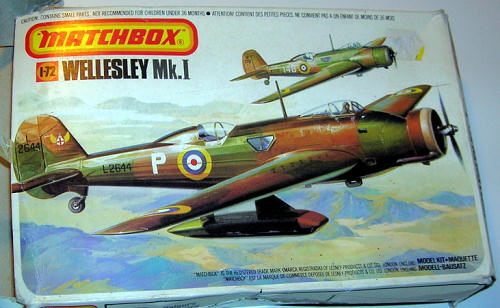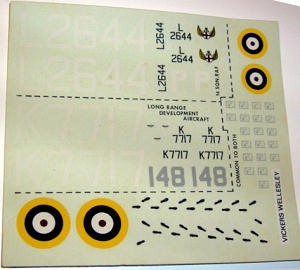Matchbox 1/72 Wellesley I
|
KIT #: |
PK-123 |
|
PRICE: |
Not currently in production
|
|
DECALS: |
Two options |
|
REVIEWER: |
Alun Beard |
|
NOTES: |
|

Although
a relatively little known machine in the annals of WW II, the Wellesley was, in
fact, the only RAF aircraft to operate during an 18 month campaign in East
Africa against the Italian forces, making many unescorted raids deep into enemy
territory. The
Wellesley
had briefly gained fame in 1938 because of an epic long distance flight of
7,158.5 miles, a record unchallenged until November 1945, when a Boeing B-29,
(at the third attempt) surpassed it.
Wellesleys
introduced into the RAF the Barnes Wallis geodetic construction which was later
used on the
Wellington
bomber. The
Wellesley
was developed from a private venture monoplane version of the Vickers tender to
the air ministry specifications G4/31 for a general purpose land plane, the
original machine being flown on
19th
June 1935.
The first production aircraft flew on
4th
March, 1937.
The Wellesley was a significant milestone in RAF history, being capable of
lifting over 1.5 times its own weight, and introducing underwing hardpoints for
carrying its bomb load as is common on modern aircraft.
 This is
a fairly old kit (the box is dated 1979), but looks rather nice on the sprues.
Those of you familiar with Matchbox kits will know roughly what to expect – some
fine raised ribbing and framing details on the fuselage and wings, rather
heavily engraved panel lines and control surfaces, and little in the way of
interior detail. The pilot gets a very simple seat, a control column, and a
small instrument panel. The rear gunner gets only a “shelf” to sit on, and a
machine gun. Scratchbuilders will have plenty to do here. The kit can be built
as one of two aircraft – a standard Mk.I bomber, or a machine from the RAF’s
Long
Range
Development Unit, who set the record flight of 7, 158.5 miles in 1938. The
differences are in the nose – the standard bomber nose has a tapered shape with
the engine (a
Bristol
Pegasus) mounted in a Townend ring at the end, whereas the LRDU machine has a
wider nose with a fully cowled engine. Separate parts for both variants are
provided. The Mk.I also carries underwing bomb panniers, not fitted to the LRDU
aircraft. Landing gear can be built raised or lowered, but the wells contain no
detail, so you may wish to do some work in this area. Parts are moulded on three
sprues, all different colours (black, green and brown). Transparencies consist
of canopies for the pilot and rear gunner, and two small windows in the fuselage
sides above the wing. They are quite thick, but clear and flash-free. There is
little flash on any other parts either.
This is
a fairly old kit (the box is dated 1979), but looks rather nice on the sprues.
Those of you familiar with Matchbox kits will know roughly what to expect – some
fine raised ribbing and framing details on the fuselage and wings, rather
heavily engraved panel lines and control surfaces, and little in the way of
interior detail. The pilot gets a very simple seat, a control column, and a
small instrument panel. The rear gunner gets only a “shelf” to sit on, and a
machine gun. Scratchbuilders will have plenty to do here. The kit can be built
as one of two aircraft – a standard Mk.I bomber, or a machine from the RAF’s
Long
Range
Development Unit, who set the record flight of 7, 158.5 miles in 1938. The
differences are in the nose – the standard bomber nose has a tapered shape with
the engine (a
Bristol
Pegasus) mounted in a Townend ring at the end, whereas the LRDU machine has a
wider nose with a fully cowled engine. Separate parts for both variants are
provided. The Mk.I also carries underwing bomb panniers, not fitted to the LRDU
aircraft. Landing gear can be built raised or lowered, but the wells contain no
detail, so you may wish to do some work in this area. Parts are moulded on three
sprues, all different colours (black, green and brown). Transparencies consist
of canopies for the pilot and rear gunner, and two small windows in the fuselage
sides above the wing. They are quite thick, but clear and flash-free. There is
little flash on any other parts either.
Instructions are typical of Matchbox, consisting of a single large sheet of
newspaper-grade paper. Assembly is detailed in 8 steps, with alternative
variants shown clearly so confusion should be easily avoided. There are also two
further images showing
 decal placements, and Humbrol colours are called out in a
table. The paint schemes for the two machines are fairly similar, and are shown
on the back of the box.
decal placements, and Humbrol colours are called out in a
table. The paint schemes for the two machines are fairly similar, and are shown
on the back of the box.
The kit
decals are rather yellowed, but this is hardly surprising given their age.
Replacements should be easy to find if required as they are pretty
run-of-the-mill for the pre-war RAF. The sheet is split into three sections,
with one for 14 Squadron, one for the LRDU, and one for common markings
(roundels, wing walkways, etc).
This is
an old kit, by a maker well known for their shortcomings and issues. That said,
the subject is a rare one, and I very much doubt if anyone else will release a
Wellesley
any time soon. The expert modeller will be able to go to town on this kit, and
turn out a stunning model, while the less experienced will still end up with a
nice-looking model of an unusual aircraft. Recommended (if you can find one!).
Kit instructions
Alun Beard
October 2009If you would like your product reviewed fairly and quickly, please
contact
me or see other details in the
Note to
Contributors.
Back to the Main Page
Back to the Previews Index Page


 This is
a fairly old kit (the box is dated 1979), but looks rather nice on the sprues.
Those of you familiar with Matchbox kits will know roughly what to expect – some
fine raised ribbing and framing details on the fuselage and wings, rather
heavily engraved panel lines and control surfaces, and little in the way of
interior detail. The pilot gets a very simple seat, a control column, and a
small instrument panel. The rear gunner gets only a “shelf” to sit on, and a
machine gun. Scratchbuilders will have plenty to do here. The kit can be built
as one of two aircraft – a standard Mk.I bomber, or a machine from the RAF’s
This is
a fairly old kit (the box is dated 1979), but looks rather nice on the sprues.
Those of you familiar with Matchbox kits will know roughly what to expect – some
fine raised ribbing and framing details on the fuselage and wings, rather
heavily engraved panel lines and control surfaces, and little in the way of
interior detail. The pilot gets a very simple seat, a control column, and a
small instrument panel. The rear gunner gets only a “shelf” to sit on, and a
machine gun. Scratchbuilders will have plenty to do here. The kit can be built
as one of two aircraft – a standard Mk.I bomber, or a machine from the RAF’s
 decal placements, and Humbrol colours are called out in a
table. The paint schemes for the two machines are fairly similar, and are shown
on the back of the box.
decal placements, and Humbrol colours are called out in a
table. The paint schemes for the two machines are fairly similar, and are shown
on the back of the box.